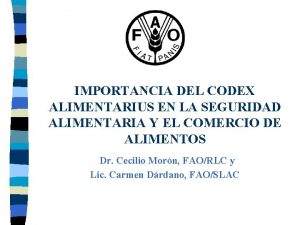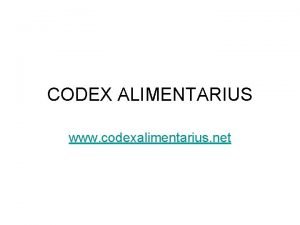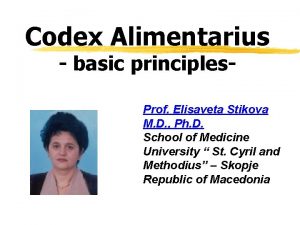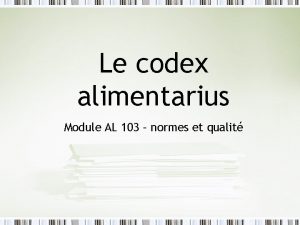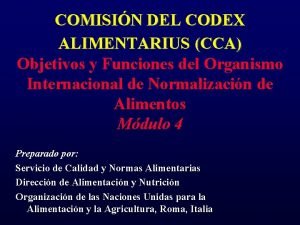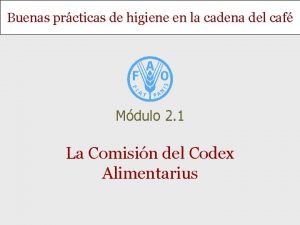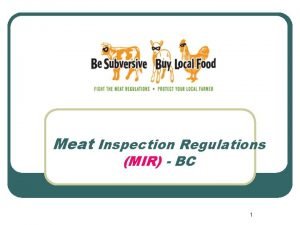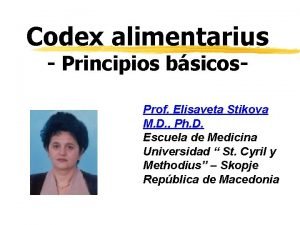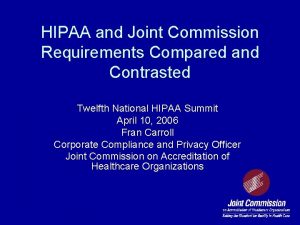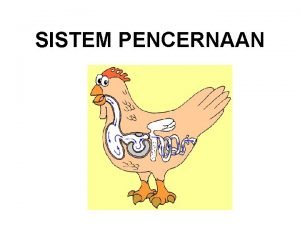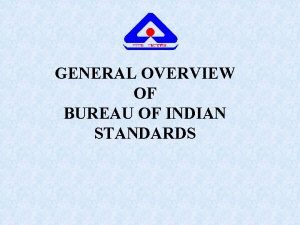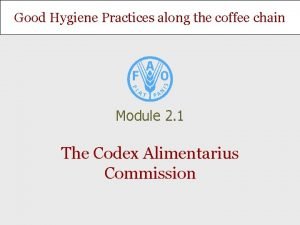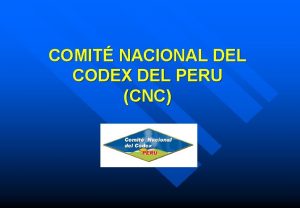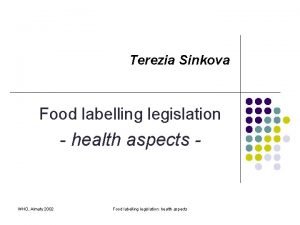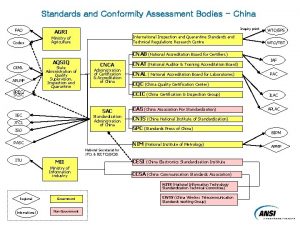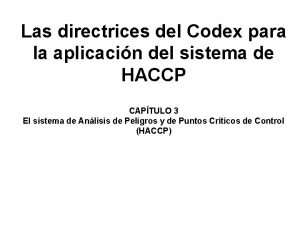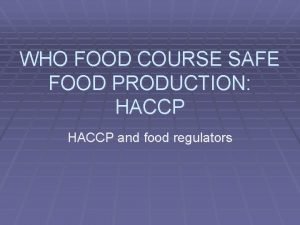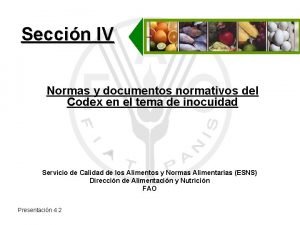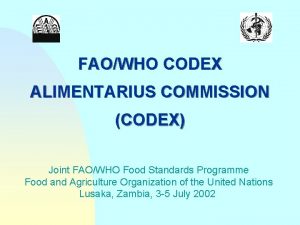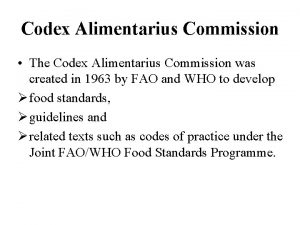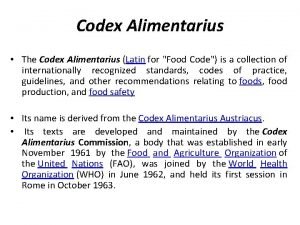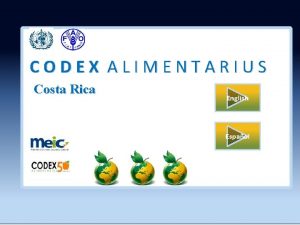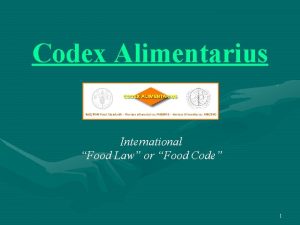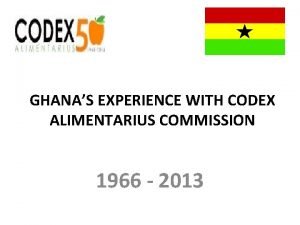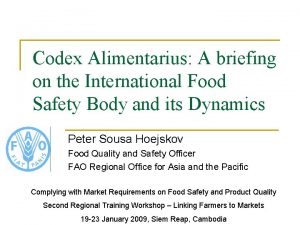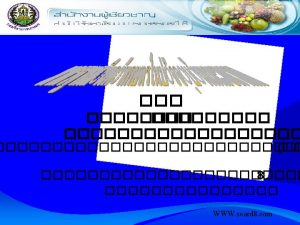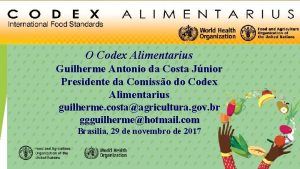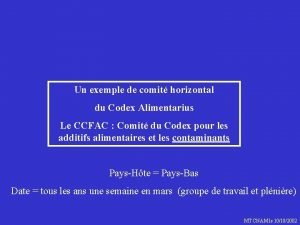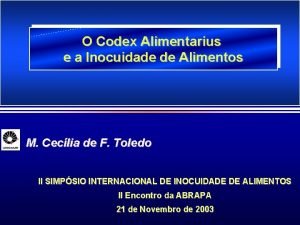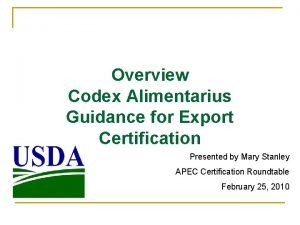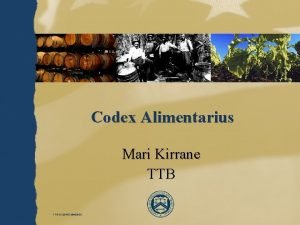Joint FAOWHO Food Standards Programme Codex Alimentarius Commission





















- Slides: 21

Joint FAO/WHO Food Standards Programme Codex Alimentarius Commission Structure, Activities, Cooperation Symposium - Trade Rules, Regulations and Standards: Different Levels of Rule Making and their Impact (Geneva, 23 October 2007) Tom Heilandt, Codex Secretariat - C O D E X A L I M E N T A R I US

About Codex Alimentarius v v CODEX ALIMENTARIUS is latin for food code THE Codex Alimentarius is a collection of food standards, guidelines and codes of practice developed by the Codex Alimentarius Commission - C O D E X A L I M E N T A R I US

A bit of history: Before Codex 1891 Codex Alimentarius Austriacus 1945 FAO 1947 UNECE, GATT 1948 WHO, OEEC (from 1961 OECD) 1950 Experts at the first meeting of the Joint FAO/WHO Expert Committee on Nutrition stated: "Food regulations in different countries are often conflicting and contradictory. Legislation governing preservation, nomenclature and acceptable food standards often varies widely from country to country. New legislation not based on scientific knowledge is often introduced, and little account may be taken of nutritional principles in formulating regulations". 1954 -1958 Austria actively pursued the creation of a regional food code, the Codex Alimentarius Europaeus - C O D E X A L I M E N T A R I US

A bit of history: Creation of the Codex Alimentarius Commission v February 1961 FAO, WHO, UNECE, OECD and the Council of the European Codex Alimentarius Europaeus discussed proposals for an international food standards program. v October 1962 Joint FAO/WHO Conference on Food Standards in the Palais des Nations, Geneva to establish the framework for cooperation between the two agencies. v June/July 1963 First Session of the Codex Alimentarius Commission (120 delegates from 30 countries) - C O D E X A L I M E N T A R I US

Codex Alimentarius Commission Mandate v v v To protect the health of consumers To ensure fair practices in international food trade To coordinate all food standardization work done by international organizations - C O D E X A L I M E N T A R I US

Codex Alimentarius Commission Basic facts (2007) v v v 175 Member countries and One Member Organization (EC) Covering 99% of the worlds population IGO Observers 157 International NGO observers from science, industry, consumers 30 th Session of the Commission attended by over 500 delegates from 123 members - C O D E X A L I M E N T A R I US

Codex Alimentarius Commission Work organization v v Work is based on independent scientific advice provided by FAO/WHO in accordance with Risk Analysis principles Consensus whenever possible to ensure broad acceptance of standards - Votes are possible but rare Frequency: Committees/ task forces: every 12 to 24 months - Executive Committee: twice annually - Commission: presently annually Hardly a week in any year without a Codex Meeting somewhere (including meetings of governing bodies, scientific advice, working groups) - C O D E X A L I M E N T A R I US

Codex organizational chart CODEX ALIMENTARIUS COMMISSION Secretariat Executive Committee General Subject Committees General Principles (France) Methods of Analysis and Sampling (Hungary) Food Additives (China) Pesticide Residues (China) Contaminants in Foods (Netherlands) Residues of Veterinary Drugs in Foods (USA) Food Hygiene (USA) Food Labelling (Canada) -Food Import and Export Inspection and Certification Systems (Australia) Nutrition and Foods for Special Dietary Uses (Germany) Commodity Committees active Milk and Milk Processed Fruits Products (New Zealand) and Vegetables (USA) Fish and Fishery Products (Norway) Fresh Fruit and Vegetables (Mexico) adjourned Cereals, Pulses and Legumes (USA) Africa (Morocco) Asia (Republic of Korea) Meat Hygiene (New Zealand) Vegetable Proteins (Canada) Natural Mineral Waters Cocoa Products and Chocolate (Switzerland) Near East (Jordan) ad hoc Intergovernmental Task Forces Biotechnology (Japan) Antimicrobial Resistance (Republic of Korea) Processing and Handling of Quick Frozen Foods (Thailand) dissolved Fruit and Vegetable Juices (Brazil) - C O D E X Latin America and the Caribbean (Argentina) North America and the Southwest Pacific (Samoa) Europe (Switzerland) Fats and Oils (United Kingdom) Sugars (United Kingdom) Regional Coordinating Committees A L I M E N T A R I US Animal Feeding (Denmark)

Codex Alimentarius “Score card” v v v v Commodity standards: 186 Commodity related texts: 46 Food Labelling: 9 Food Hygiene: 5 Food safety risk assessment: 3 Sampling and analysis: 15 Inspection and certification procedures: 8 Animal food production: 6 Contaminants in food: 12 Food additives texts: 7 Food additives provisions: 1112, covering 292 food additives MRL for pesticides: 2886, covering 213 pesticides MRL for veterinary drugs in foods: 441, covering 49 veterinary drugs - C O D E X A L I M E N T A R I US

WTO Agreement and Codex v Agreement on the Application of Sanitary and Phytosanitary Measures (SPS Agreement) – The SPS Agreement calls on countries to harmonize their national standards with “international standards, guidelines or recommendations ”(Article 3. 1). – Codex Standards are defined as “international standards, guidelines or recommendations” for food safety (Annex A). (IPPC and OIE are also mentioned – 3 sisters) v Agreement on Technical Barriers to Trade (TBT Agreement) – The TBT Agreement calls on countries to use relevant international standards when they exist (Article 2. 4). - C O D E X A L I M E N T A R I US

Codex/UNECE previous joint work – cooperation areas CODEX ALIMENTARIUS COMMISSION Secretariat Executive Committee General Subject Committees General Principles (France) Methods of Analysis and Sampling (Hungary) Food Additives (China) Pesticide Residues (China) Contaminants in Foods (Netherlands) Residues of Veterinary Drugs in Foods (USA) Food Hygiene (USA) Food Labelling (Canada) -Food Import and Export Inspection and Certification Systems (Australia) Nutrition and Foods for Special Dietary Uses (Germany) Commodity Committees active Milk and Milk Processed Fruits Products (New Zealand) and Vegetables (USA) Fish and Fishery Products (Norway) Fresh Fruit and Vegetables (Mexico) adjourned Cereals, Pulses and Legumes (USA) Africa (Morocco) Asia (Republic of Korea) Meat Hygiene (New Zealand) Vegetable Proteins (Canada) Natural Mineral Waters Cocoa Products and Chocolate (Switzerland) Near East (Jordan) ad hoc Intergovernmental Task Forces Biotechnology (Japan) Antimicrobial Resistance (Republic of Korea) Processing and Handling of Quick Frozen Foods (Thailand) dissolved Fruit and Vegetable Juices (Brazil) - C O D E X Latin America and the Caribbean (Argentina) North America and the Southwest Pacific (Samoa) Europe (Switzerland) Fats and Oils (United Kingdom) Sugars (United Kingdom) Regional Coordinating Committees A L I M E N T A R I US Animal Feeding (Denmark)

Codex/UNECE previous joint work – cooperation areas Secretariat Commodity Committees Regional Coordinating Committees active Processed Fruits and Vegetables (USA) Fresh Fruit and Vegetables (Mexico) Europe (Switzerland) adjourned Cereals, Pulses and Legumes (USA) ad hoc Intergovernmental Task Forces Processing and Handling of Quick Frozen Foods (Thailand) dissolved Fruit and Vegetable Juices (Brazil) - C O D E X A L I M E N T A R I US

Main present cooperation: Fresh Fruits and Vegetables v v v Before 1988 – UNECE and OECD work on FFV standards with clear division of labour 1988 Codex Committee on Tropical Fresh Fruits and Vegetables (CCTFFV) 1995 Creation of WTO 1995 “Tropical” deleted from TOR of CCTFFV 1998 OECD changes TOR to include as first objective to promote establishment of one single international organization dealing with standardization of FFV – WG or Secretariats 2006 and ongoing UNECE and OECD discuss concentration of work - C O D E X A L I M E N T A R I US

UNECE standards for FFV Annonas Apples Apricots Artichokes Asparagus Aubergines Avocados Beans Bilberries and Blueberries Broccoli Brussels sprouts Headed Cabbages Carrots Cauliflowers Ceps Chinese Cabbages Cherries Chicory (Witloof) - Citrus fruit Cucumbers Courgettes Cultivated mushrooms Edible sweet chestnuts Fennel Fresh figs Garlic Horse-radish Kiwifruit Leeks Lettuce and endives Mangoes Melons Onions Peaches and Nectarines Pears Peas C O D E X Pineapples Plums Potatoes, Early and Ware Radishes Raspberries Ribbed celery Rhubarb Scorzonera Spinach Strawberries Sweet peppers Table grapes Tomatoes Truffles Watermelons A L I M E N T A R I US

Codex Standards for FFV Asparagus Avocado Baby Corn Bananas Cape Gooseberry Carambola Chayotes Dates Fresh Fungus "Chanterelle" Ginger Grapefruits (Citrus paradisi) - Guavas Limes Litchi Longans Mangosteens Mexican Limes Nopal Oranges Papaya Pineapple C O D E X Pitahayas Prickly Pear Pummelos (Citrus grandis) Rambutan Sweet Cassava Table Grapes Tannia A L I M E N T A R I US

Ongoing and future work v v Ongoing work in CCFFV: Apples, Bitter Cassava, Tomatoes Priority list CCFFV: Avocados (revision), Chanterelle (revision), Durian, Chili Peppers, Kiwi, Garlic, Passion Fruit, Onion, Pears, Peppers, Pineapple (revision), Strawberry, Tree tomatoes Ongoing work UNECE (new): Chili Peppers, Chanterelle ONgoing work UNECE (revision) : Early and Ware Potatoes, Apricots, Cucumbers, Peaches and Nectarines, Sweet Peppers, Table Grapes, Apples - C O D E X A L I M E N T A R I US

Participation sample Codex/UNECE FFV v Participation CCFFV 13 th Session 2006 - 34 countries v Antigua and Barbuda, Argentina, Australia, Brazil, Chile, Canada, China, Colombia, Cuba, Fiji, Finland, Czech Republic, France, Greece, Germany, India, Indonesia, Italy, Jamaica, Malaysia, Mexico, Morocco, Netherlands, New Zealand, Peru, Poland, South Africa, Spain, Switzerland, Thailand, Tonga, Trinidad and Tobago, Turkey and United States of America v Participation UNECE GE. 1 53 rd Session 2007 - 25 countries: v Austria, Belgium, Canada, Czech Republic, Denmark, Finland, France, Germany, Greece, Hungary, Ireland, Israel, Italy, Mexico, Morocco, Netherlands, New Zealand, Poland, Slovakia, Spain, Sweden, Switzerland, Turkey, United Kingdom of Great Britain and Northern Ireland, and United States of America - C O D E X A L I M E N T A R I US

Conclusions v v v There is a lot of work - enough for all. Countries wish to maintain activity on FFV both at Codex and at UNECE level – the standards are used and needed. This can lead to problems e. g. new work or revision work on same products at the same time. Maximum gain should be sought from the joint expertise and the differences in attendance and work style. Organizations can fulfill complementary roles Secretariats cannot avoid duplication only members can do that with their decisions. - C O D E X A L I M E N T A R I US

How to increase gain v Apply existing rules (as already proposed by Secretariats): The Working Party on Agricultural Quality Standards of the United Nations Economic Commission for Europe: 2. may prepare “proposed draft standards” for fresh fruits or vegetables at the request of the Codex Committee on Fresh Fruits and Vegetables or of the Commission for distribution by the Codex Secretariat at Step 3 of the Codex Procedure, and for further action by the Codex Committee on Fresh Fruits and Vegetables; 4. may perform specific tasks in relation to the elaboration of standards for fresh fruits and vegetables at the request of the Codex Committee on Fresh Fruits and Vegetables. v v v Find new areas for cooperation e. g. Meat Work together on the future of commodity standards, simplification, generalization, inner quality Work together on the impact of private standards - C O D E X A L I M E N T A R I US

New possible cooperation … Meat v CAC/RCP 7 : Recommended International System for the Description of Carcases of Bovine and Porcine Species and Recommended International Description of Cutting Methods - C O D E X A L I M E N T A R I US

- C O D E X A L I M E N T A R I US
 Porque es importante el codex alimentarius
Porque es importante el codex alimentarius Codex alimentarius mermelada
Codex alimentarius mermelada Elisaveta stikova
Elisaveta stikova Arbre de decision haccp
Arbre de decision haccp Funciones del codex alimentarius
Funciones del codex alimentarius Normas verticales y horizontales del codex alimentarius
Normas verticales y horizontales del codex alimentarius Fritz ter meer codex alimentarius
Fritz ter meer codex alimentarius Principios del codex alimentarius
Principios del codex alimentarius Joint commission accreditation standards
Joint commission accreditation standards Intestine
Intestine Defect of secondary education
Defect of secondary education Graduated commission examples
Graduated commission examples Codex vgm
Codex vgm Codex alementarius
Codex alementarius Codex coffee
Codex coffee Codex peru
Codex peru Codex stan 1-1985, rev. 1-1991
Codex stan 1-1985, rev. 1-1991 Codex ilaç
Codex ilaç Codex
Codex Jamnia israel
Jamnia israel Codex decision tree
Codex decision tree Codex
Codex
